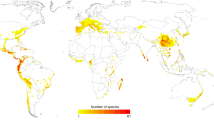Abstract
Callimorpha jacobaeae L. (the cinnabar moth) has a brilliant red and blackish warning coloration (aposematic), and is a day-flying moth known to be unacceptable to a wide variety of vertebrate predators1–3. The larva, which feeds on groundsel (Senecio vulgaris L.) and ragwort (Senecio jacobaeae L.), has a black and yellow warning coloration and is rejected by many birds, mammals, reptiles and amphibians; it is, however, preyed upon by various arthropods4. When roughly handled the imago ejects or leaks out a pungent secretion mixed with yellow haemolymph from its prothoracic glands5. The adult moth contains a remarkably high level of histamine in its body tissues (700 µg/g)—a substance frequently associated with poison glands in invertebrates6–8.
This is a preview of subscription content, access via your institution
Access options
Subscribe to this journal
Receive 51 print issues and online access
$199.00 per year
only $3.90 per issue
Buy this article
- Purchase on Springer Link
- Instant access to full article PDF
Prices may be subject to local taxes which are calculated during checkout
Similar content being viewed by others
References
Windecker, W., Z. Morphol. Okol. Tiere, 35 (1), 84 (1939).
Frazer, J. F. D., and Rothschild, M., Proc. Eleventh Intern. Congr. Ent., 1960 (B), 3, 249 (1960).
Rothschild, M., The Entomologist, 97, 73 (1964).
Wilkinson, A. T. S., Proc. Entomol. Soc., 62, 10 (1965).
Rothschild, M., Trans. Roy. Entomol. Soc., 113 (5), 101 (1961).
Bissett, G. W., Frazer, J. F. D., Rothschild, M., and Schachter, M., J. Physiol., 146, 38 (1959).
Von Euw, J., Fishelson, L., Parsons, J. A., Reichstein, T., and Rothschild, M., Nature, 214, 35 (1967).
Crescitelli, F., and Geissman, T. A., Ann. Rev. of Pharmac., 2 (1962).
Rothschild, M., Proc. Roy. Entomol. Soc. (A), 38 (7), 159 (1963).
Hill, R. K., Markson, L. M., and Schoental, R., Proc. Roy. Sci., Med., 53, 281 (1960).
Mattocks, A. R., Nature, 217, 723 (1968).
Rothschild, M., Proc. Roy. Entomol. Soc. (C), 31 (6), 31 (1966).
Chalmers, A. H., Culvenor, C. C. J., and Smith, L. W., J. Chromatog., 20, 270 (1965).
Gouindachari, T. R., The Alkaloids (edit. by Manski, R. H. F.), 9, 517 (Academic Press Inc., New York, 1967).
Meinwald, J., and Meinwald, Y. C., J. Amer. Chem. Soc., 88, 1305 (1966).
Self, L. S., Guthrie, F. E., and Hodgson, E., Nature, 204, 200 (1964).
Chakravati, D., Chakravati, N. R., Cohen, L. A., Dasgupta, B., Datta, S., and Miller, H. K., Tetrahedron, 16, 224 (1961).
Meinwald, Y. C., Meinwald, J., and Eisner, T., Science, 154, 390 (1966).
Author information
Authors and Affiliations
Rights and permissions
About this article
Cite this article
APLIN, R., BENN, M. & ROTHSCHILD, M. Poisonous Alkaloids in the Body Tissues of the Cinnabar Moth (Callimorpha jacobaeae L.). Nature 219, 747–748 (1968). https://doi.org/10.1038/219747a0
Received:
Issue Date:
DOI: https://doi.org/10.1038/219747a0
This article is cited by
-
Effects of pyrrolizidine alkaloids through different trophic levels
Phytochemistry Reviews (2011)
-
10.1007/BF00187733
CrossRef Listing of Deleted DOIs (2011)
-
Insect-synthesised Retronecine Ester Alkaloids: Precursors of the Common Arctiine (Lepidoptera) Pheromone Hydroxydanaidal
Journal of Chemical Ecology (2007)
-
Relative importance of fertiliser addition to plants and exclusion of predators for aphid growth in the field
Oecologia (2005)
-
Sequestration ofVeratrum alkaloids by specialistRhadinoceraea nodicornis konow (Hymenoptera, Tenthredinidae) and its ecoethological implications
Journal of Chemical Ecology (1994)
Comments
By submitting a comment you agree to abide by our Terms and Community Guidelines. If you find something abusive or that does not comply with our terms or guidelines please flag it as inappropriate.



